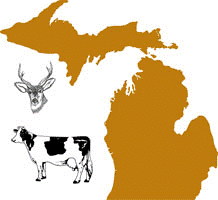Wildlife Disease and Zoonotics

Michigan Bovine Tuberculosis Bibliography and Database
Date of this Version
2008
Abstract
Bovine tuberculosis (bTB) is a contagious disease of livestock, wildlife, and humans. Typically, it is transmitted through inhalation of aerosolized bacilli and direct or indirect contact between animals. In northeastern Michigan, bTB is endemic in white-tailed deer, and evidence suggests deer have spread the disease to domestic cattle. Previous research indicates bTB transmission likely occurs through contamination of cattle feeding sources by infected deer and subsequent use by cattle. We are investigating deer movements in relation to farm management practices such as feeding schedules as well as locations of cattle feeding areas, hay storage sites, barns, and water sources. All locations are plotted using ArcMap software. Regular communication with cooperators allows for updates in feeding schedules and locations. We are capturing free-ranging white-tailed deer and fitting them with radio collars equipped with a global positioning system (GPS). As of 15 February 2008, we have retrieved GPS collars from 7 of 16 deer collared in 2007, and 7 new collars have been deployed since 1 January 2008. Each retrieved collar has recorded over 2,500 data points, and preliminary results suggest individual deer are staying within 1.5 km of their capture site. Spatial analysis on deer locations relative to livestock management practices and farm structures will take place when all data is retrieved in late 2008 and early 2009. Once complete, we hope this information will allow us to recommend mitigating measures for livestock producers to reduce the risk of transmission of bTB from free ranging white-tailed deer to domestic cattle.


Comments
Proc. 23rd Vertebr. Pest Conf. (R. M. Timm and M. B. Madon, Eds.)
Published at Univ. of Calif., Davis. 2008. Pp. 277-279.